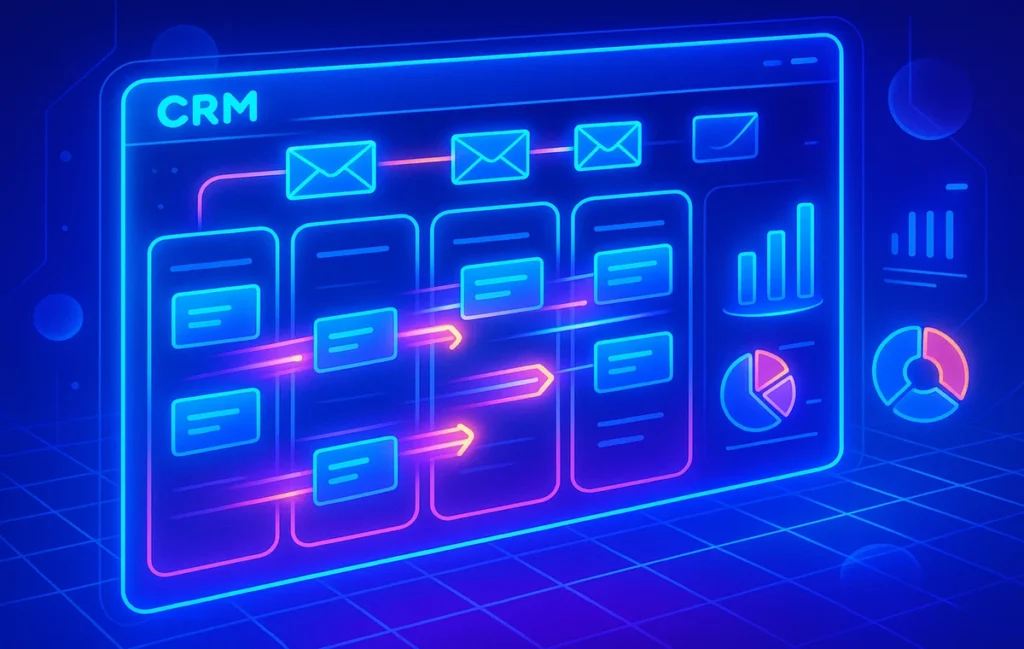🚀 Why Pipedrive Stands Out in the CRM Landscape
When businesses start searching for a CRM, they often get overwhelmed by platforms that feel bloated or too enterprise-focused. Pipedrive has carved out a space by staying laser-focused on one thing: making pipeline management intuitive and actionable. While competitors like HubSpot (see our HubSpot CRM Review) or Salesforce Essentials emphasize broad marketing integrations, Pipedrive positions itself as the CRM “built by salespeople, for salespeople.”
At NerdChips, we see Pipedrive as a smart fit for teams that value visual deal management, simple email sync, and straightforward reporting—without the learning curve of larger systems. Let’s dive into how its pipelines, email capabilities, and analytics hold up in real-world use.
💡 Nerd Tip: The best CRM isn’t the one with the most features—it’s the one your team actually uses daily.
📊 Pipelines & Deal Stages: Pipedrive’s Core Strength
The pipeline view is Pipedrive’s heartbeat. Deals flow across customizable stages like a Kanban board, giving sales teams immediate visibility into what’s moving and what’s stuck. Compared to generic CRMs that bury opportunities under forms and filters, Pipedrive thrives on simplicity.
For example, a B2B agency can set up stages like New Inquiry → Demo Scheduled → Proposal Sent → Negotiation → Closed Won/Lost. Each deal is a card you drag between stages. This tactile flow keeps salespeople engaged, reducing data neglect. In fact, a sales director we spoke with noted their reps increased CRM usage by 35% after switching to Pipedrive, simply because the pipeline felt natural.
Automation adds another layer: moving a deal into “Proposal Sent” can trigger a reminder to follow up in three days. This design makes pipelines not just visual but actionable, helping teams stay proactive rather than reactive.
💡 Nerd Tip: Keep pipeline stages tied to actions, not vague sentiments. “Negotiation” works better than “Interested,” because it signals what the rep must do next.
If you’re comparing options, check our guide on Best Lightweight CRMs for Micro-Businesses to see how Pipedrive stacks up against rivals like Zoho or HubSpot.
📧 Email Sync & Automation: Closing the Communication Loop
One pain point for many SMBs is toggling between CRM and inbox. Pipedrive solves this with robust email sync for Gmail, Outlook, and other providers. Once connected, every sent or received email can be linked to the relevant deal, keeping context centralized.
For lean teams, this is a game-changer. Imagine receiving a client’s reply—without leaving your CRM, you can respond, log the interaction, and update the deal status. This tight integration reduces “lost in inbox” moments that plague small sales teams.
Beyond sync, Pipedrive offers email templates and simple automations. For example, a rep can set a workflow so that every new deal added to the pipeline triggers a personalized welcome email. While this isn’t as advanced as marketing automation platforms (see CRM vs. Marketing Automation), it covers the essentials without overwhelming users.
💡 Nerd Tip: Use automation sparingly. Over-templated outreach risks sounding robotic. Pair automated follow-ups with personalized touches to keep relationships authentic.
For teams balancing outbound efforts, connecting Pipedrive with Best Lead Generation Software creates a seamless path from prospecting to pipeline.
📈 Reporting & Insights: The Balance of Simplicity and Depth
Reporting is where many CRMs drown users in complexity. Pipedrive takes a balanced approach, offering visual dashboards with core metrics like deal velocity, conversion rates by stage, and revenue forecasting.
For example, managers can quickly spot bottlenecks—if 40% of deals stall at “Proposal Sent,” the issue may lie in offer positioning or pricing. Another strength is activity reporting, which ties completed calls, meetings, and emails back to outcomes. Sales leaders often use this to coach reps, ensuring effort aligns with results.
However, limitations exist. While the default reports cover most SMB needs, advanced segmentation and cross-object analytics are less flexible compared to enterprise tools. If you want multi-channel attribution or AI-driven insights, you may need integrations with Content Marketing Platforms or BI tools.
💡 Nerd Tip: Don’t chase vanity metrics. Focus on KPIs like stage-to-stage conversion rate or average deal cycle time—these directly affect revenue.
Despite its lighter analytics, many teams praise Pipedrive’s clarity. One user on X shared:
“Switched from Salesforce to Pipedrive. Reporting isn’t as deep, but my reps actually use it. That alone is ROI.”
👥 Who It’s For (and Who It’s Not)
Who It’s For:
Pipedrive shines for small-to-midsize businesses and sales-driven teams that prioritize pipeline visibility over marketing bells and whistles. Agencies, B2B consultancies, and startups with 2–50 reps often find it the perfect balance of usability and power.
Who It’s Not For:
If you’re running complex, multi-channel marketing campaigns with deep automation needs, Pipedrive may feel limiting. Enterprises needing advanced customization, AI-driven lead scoring, or broad platform ecosystems may prefer HubSpot, Zoho, or Salesforce Essentials.
💡 Nerd Tip: Try Pipedrive if your first question is “Where are my deals right now?” Skip it if your first question is “How do I nurture leads across 12 marketing channels?”
⚡ Ready to Streamline Your Sales Pipeline?
Explore CRMs like Pipedrive to simplify deal tracking, sync emails, and unlock clear reporting. Perfect for lean teams needing visibility.
🔗 Integrations & Ecosystem Fit
A CRM rarely operates in isolation. For many businesses, the real question isn’t just “What can this tool do?” but “How does it fit into the ecosystem we already use?” Pipedrive scores well here by providing a broad set of integrations through both native connections and platforms like Zapier.
On the sales side, integrations with LinkedIn’s Sales Navigator and email providers (Gmail and Outlook) ensure prospecting and communication flow directly into the pipeline. For marketing workflows, Pipedrive connects with tools like Mailchimp and integrates smoothly with Content Marketing Platforms, so campaigns can align with sales outreach. On the operational side, Zapier unlocks connections to thousands of apps—from Slack notifications when deals move stages to auto-creating tasks in project management platforms like Trello or Asana.
💡 Nerd Tip: Don’t overload integrations. Start with the “critical three”—email, calendar, and one marketing tool—before layering on more. Too many connections can lead to clutter and sync errors.
By positioning itself as an adaptable hub rather than a closed ecosystem, Pipedrive allows SMBs to build out a tech stack at their own pace, avoiding the vendor lock-in that sometimes frustrates users of more rigid CRMs.
📱 Mobile App Experience
For modern sales teams, work doesn’t just happen at the desk. Many reps are on the road, meeting clients, or working in the field. Pipedrive’s mobile app (iOS and Android) gives these users the ability to manage deals, update pipelines, and log activities on the go.
The standout feature is the ability to move deals between stages with a simple swipe, mirroring the desktop pipeline’s Kanban-style flow. Reps can also scan business cards directly into the CRM, automatically creating new contacts. Calendar sync ensures meetings appear seamlessly in-app, and push notifications remind reps of follow-ups before calls or meetings slip through the cracks.
However, some users note that advanced reporting features feel limited on mobile compared to desktop. For managers, that means performance tracking is still best done at the office. But for sales reps in the field, the mobile experience is strong enough to keep pipelines updated in real time—a key driver of CRM adoption.
💡 Nerd Tip: Encourage reps to log notes immediately after meetings in the app. Fresh details are more valuable than end-of-day summaries, and the mobile app makes this frictionless.
💵 Pricing & Value for Money
Pipedrive positions itself in the mid-market: more affordable than enterprise CRMs like Salesforce, but more structured and sales-focused than free tools. Pricing is divided into tiers:
-
Essential: Covers basic pipelines, email sync, and simple reporting.
-
Advanced: Adds workflow automation and enhanced email tracking.
-
Professional: Expands reporting, adds forecasting, and more collaboration features.
-
Enterprise: Custom support and advanced permissions for larger teams.
Entry-level pricing starts competitively, often less than $20 per user per month. For SMBs, this makes Pipedrive attractive: it delivers professional-grade pipeline management without forcing teams into expensive enterprise contracts.
The real value lies in scaling. A two-person startup may thrive on the Essential plan, while a 20-person sales team will likely need Professional. The upgrade path is natural, but users should be mindful: adding features like advanced automation or detailed reporting requires higher tiers, and costs can rise quickly as team sizes grow.
💡 Nerd Tip: Audit your feature usage every quarter. If your team isn’t actively using advanced reports or automation, consider downgrading. Paying only for what you need keeps ROI high.
🛡️ Limitations & Common Complaints
No tool is perfect, and a fair review means highlighting weaknesses alongside strengths. Pipedrive’s limitations mostly surface when businesses begin scaling beyond the SMB stage.
Reporting, while clear and visual, is sometimes criticized for being too surface-level. Advanced segmentation, multi-channel attribution, and deep marketing analytics are not native strengths. Some teams integrate Pipedrive with BI tools to fill this gap, but that adds complexity and cost.
Marketing automation is another limitation. Compared to full-stack CRMs like HubSpot (see our HubSpot CRM Review), Pipedrive’s automation feels lightweight. For businesses wanting email nurtures, content triggers, and multi-step customer journeys, Pipedrive may require external tools.
Finally, customization has its ceiling. While pipelines are highly flexible, certain workflow automations or data structures can’t match the flexibility of enterprise platforms.
Users on X often share this trade-off candidly:
“Love Pipedrive for pipelines, but once you start needing advanced analytics or big-team automation, it feels stretched.”
💡 Nerd Tip: Know when to graduate. Pipedrive excels for SMBs. But if your sales org grows to hundreds of reps or demands deep marketing-sales alignment, prepare for an eventual shift to a broader platform.
📬 Want More Smart AI Tips Like This?
Join our free newsletter and get weekly insights on CRMs, automation, and sales tools—delivered straight to your inbox. No fluff, just actionable reviews and strategies from NerdChips.
🔐 100% privacy. No noise. Just value-driven CRM insights from NerdChips.
🧠 Nerd Verdict
Pipedrive proves that a CRM doesn’t need to be overloaded with features to deliver value. Its pipelines are among the best in class for visual deal tracking, its email sync keeps communication in context, and its reporting provides clarity without overwhelming.
At the same time, it’s not trying to be everything. For SMBs and sales teams focused on pipeline visibility and execution, Pipedrive is a near-perfect fit. For larger enterprises needing deep automation and multi-channel orchestration, it may serve better as part of a broader stack.
At NerdChips, we rate Pipedrive as a CRM that does one thing exceptionally well: helping sales teams see, move, and close deals.
❓ FAQ: Nerds Ask, We Answer
💬 Would You Bite?
Would your team benefit more from Pipedrive’s simplicity or do you need the complexity of larger platforms?
Share your perspective—we’d love to hear how teams balance CRM usability vs. power. 👇
Crafted by NerdChips for teams who want clarity in their pipelines without the clutter.



